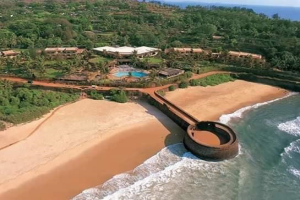Summary
Tourism contributes about 30 per cent to Goa’s gross domestic product and provides livelihood to a large number of people. However, following the outbreak and spread of COVID-19 pandemic in India, tourists have temporarily stopped visiting the state. This has led to an economic crisis.
Tourism is an important sector of the Indian economy. According to the figures published in 2019-20 Annual Report of the Indian Ministry of Tourism, tourism’s share in India’s gross domestic product (GDP) in 2013-14 was 5.68 per cent, which declined to 5.06 per cent in2016-17. In 2018, travel and tourism together contributed 9.2 per cent to India’s GDP. The total contribution of this sector to India’s economy is expected to touch ₹32,05,000 crore (S$695.88 billion) by 2028. Moreover, this sector accounts for 12.75 per cent of the total employment – 5.56 per cent direct and 7.19 per cent indirect. Statistics for 2019-20 reveal that about 87.50 million people are employed in India’s tourism sector.
In 2019, the total number of foreign tourist arrivals to India 10.89 million, which was an increase of 3.2 per cent over the same period in 2018. The Indian government is working to achieve one per cent share in world’s international tourist arrivals by 2020 and two per cent share by 2025. So far, Indian tourism highly depends on its domestic tourists. In 2018, the number of domestic tourists visiting other parts of country stood at 1,854.93 million. To give a fillip to domestic tourism, during his Independence Day speech on 15 August 2019, Indian Prime Minister Narendra Modi made an appeal to people to visit at least 15 tourist destinations before 2022 when the country marks 75 years of independence. To attract tourists, in her 2019 Union budget speech, Indian Finance Minister, Nirmala Sitharaman, announced the development of 17 iconic sites into world class tourist destination.
The outbreak of COVID-19 has halted all tourism-related activities in India and this sector is in deep crisis. According to the Federation of Association in Indian Tourism & Hospitality, the loss incurred to this sector due to COVID-19 could be around ₹10 lakh crore (S$188.11 billion). There may be also a loss of about 38 million potential jobs in India’s tourism and hospitality industry.
In India, Goa is known as the ‘tourists’ paradise’. Till 2018, when the Indian Supreme Court cancelled 88 mining leases and ordered for fresh mining leases and environmental clearances, iron ore mining accounted for around 25 per cent of this western state’s economy. It employed 250,000 people and 100,000 were engaged in ancillary industries. After mining activities were halted, the entire economic burden of Goa fell on the tourism sector.
Tourism contributes to about 30 per cent of Goa’s total GDP. About 40 per cent of its population depends on this sector for its income. There are about 3,538 hotels and category hotels in Goa. The state’s capital, Panaji, is well-known for its casinos, night clubs and pubs. There are shacks that provide a range of food and drinks as well offer beach beds on hire for tourists. The state also has ancillary services such as taxi business which has about 32,000 listed drivers apart from private taxi drivers.
COVID-19 has affected all of these businesses. According to estimates by the Travel and Tourism Association of Goa, COVID-19 is likely lead to a loss of ₹1,000 crore (S$70.67 billion) in the state’s tourism sector in March 2020. This would also lead to a loss of about 60,000 to 70,000 jobs.
To recover from this crisis, the tourism sector, like many others, has sought financial relief from the state government. Goa’s Chief Minister, Pramod Sawant, had earlier said that as the state’s economy is itself in a crisis, the government will not be able to offer any relief. However, in an interview with the Press Trust of India, Goa’s Tourism Minister, Manohar Ajgaonkar, said that his department has written to the state Chief Minister to seek help for the tourism industry from the Prime Minister’s Relief Fund for COVID-19.
Even before the spread of COVID-19, the tourism sector in Goa was already not doing too well. In 2019, the state recorded a dip of between 20 and 30 per cent in foreign tourists. In 2018, about eight million tourists visited Goa, which was just 2.9 per cent increase from 2017. However, this number came down to about seven million in 2019. People engaged in the tourism industry blame the state’s tourism department for the decline in the number of tourists as they felt that ‘Go Goa 365 Days’ promotion was not properly publicised and marketed by the department. A decrease in the number of chartered flights and the collapse of the United Kingdom-based travel company, Thomas Cook, also affected the arrival of foreign tourists. Poor infrastructure and unclean beaches have also contributed to the drop in the number of international tourists. Over the years, there has been an increase in narcotic tourism and related crimes in Goa. To address these problems and to overhaul Goa’s image, the state government has drafted a new tourism policy.
Although the state has been declared a ‘Green’ zone with zero active COVID-19 cases, it cannot allow tourists unless the pandemic situation improves across the country and the world. Even after that happens, it will take months for Goa’s tourism industry to revive and return to normalcy.
. . . . .
Dr Amit Ranjan is Research Fellow at the Institute of South Asian Studies (ISAS), an autonomous research institute at the National University of Singapore (NUS). He can be contacted at isasar@nus.edu.sg. The author bears full responsibility for the facts cited and opinions expressed in this paper.
-
 More From :
More From :
-
 Tags :
Tags :
-
 Download PDF
Download PDF



